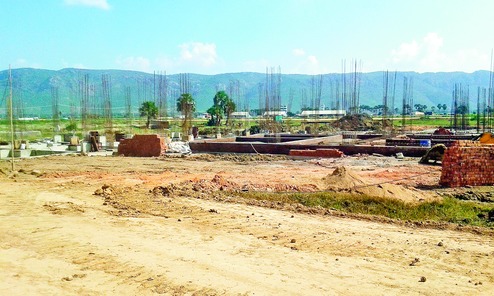
Rajgir: The upcoming Nalanda University campus in Rajgir would rely heavily on environment and would be self-reliant.
The campus, the construction work of which is going on at a war footing, will focus on zero-energy level and zero-pollution emission. The university will meet its requirement for water, electricity, fuel and even bricks from the campus. Zero-energy level or net zero building are those which is able to fulfil its need of energy requirement (power, fuel and water) from the energy generated by the building mainly from renewable sources of energy (sun and wind).
The foundation stone for the new campus was laid in March this year while construction began in May. Andhra Pradesh-based Nagarjuna Construction Company (NCC) is executing the project.
The Rs 435-crore tender has been awarded to NCC, Hyderabad, for phase-1 construction of what would be a "net zero" campus. The Rs 300-crore second phase of construction work is for residential buildings and hostels.
The first phase of the campus will have academic blocks, administrative blocks, auditorium, library and other buildings. There will be 17 buildings of G+3 height and around 50 classrooms will be constructed in the first phase.
The first phase construction work will be completed by February 2020. MGCPL Panchkula received the first tender for construction of internal roads and water bodies.
The 455 acres acquired and donated by the Bihar government in 2011 stood deserted a year back, with no construction work being carried out in the first six years.

This year, with the appointment of chancellor Vijay Bhatkar and vice-chancellor Sunaina Singh the construction work gained momentum. A visit to the campus, which is 2.5km from Rajgir bus stand and 110km southeast of Patna, reflected that the work has gained momentum.
More than a dozen cranes and equal number of earth-moving machines have been pressed for service.
An official from Nagarjuna Construction Company, looking after the construction work, said: "Apart from the dozen cranes and earth-moving machines, more than 200 workers are working on the campus. For accommodation of the workers we have built temporary structures."
In May, at the 15th governing board meeting, the board had discussed the possibility of fast-forwarding the infrastructure construction work so that a sizeable number of students could be absorbed. The 14-member Nalanda University governing board is the highest decision making body of the university and chancellor Vijay Bhatkar is the chairperson of the governing board.
Once constructed, the university estimates to have 7,000 students at its residential campus. At present, the university which is running from its transit campus near Rajgir bus stand has around 200 students in its three schools - School of Historical Studies, School of Ecology and Environment Studies and School of Buddhist Studies, Philosophy and Comparative Religions.
Vice-chancellor Sunaina Singh said: "The new Nalanda University will have shades of ancient varsity with focus on energy efficient, zero-energy level, zero-pollution emission and a green milieu."
The VC said to meet the need for water, ponds have been dug up so that water recharge takes place keeping the water table intact. The university is also planning to produce its own energy from solar power. Solar cells would be fitted above the pond that would convert solar power to electrical energy. All the buildings will be positioned along the water networks spread over the campus.
More than a dozen ponds of different sizes have been dug up at the campus. The mud removed after digging the pond is being used for making bricks. These bricks would be used to construct the buildings. The bricks are being made by compressing it at higher temperature.
An engineer engaged in the construction work said: "The bricks made by compressing the mud at higher temperature is much stronger and heavy than normal bricks. Apart from having better strength the bricks will provide more cooling than the normal ones."
Since the campus will meet minimum energy requirement from external sources, at various points on the campus, towers will be constructed that will act as air-conditioners (ACs). The towers will suck the outside air and after absorbing the moisture it will release it inside the campus. Energy-efficient desiccant evaporative (Devap) air-cooling system will be used to create a comfortable atmosphere inside the rooms.
For disposal of wastes generated from the campus, biogas plant will be constructed. The gas generated from the campus will meet the fuel requirement.
The VC said: "Apart from meeting the fuel requirement from biogas, the university has also approached the petroleum ministry to extend the Varanasi-Haldia-Barauni gas pipeline up to Rajgir. The university will use liquefied natural gas (LNG) to meet the needs of the residential staff and students once the campus is fully ready."
The VC added that there is no shortage of funds as the Centre and various countries associated with the project are contributing. According to university sources, the Government of India has paid Rs 2,727.1 crore, which is committed for 10 years. China has paid Rs 6.7 crore, Japan has committed to pay 42,852mn Yen (Rs 2,808.4 crore), as a soft loan under Japan's Overseas Development Assistance initiative.











